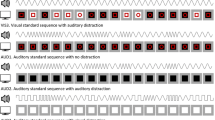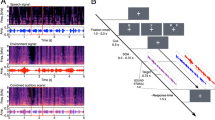Abstract
Repetition blindness (RB) is a visual deficit, wherein observers fail to perceive the second occurrence of a repeated item in a rapid serial visual presentation stream. Chen and Yeh (Psychon Bull Rev 15:404–408, 2008) recently observed a reduction of the RB effect when the repeated items were accompanied by two sounds. The current study further manipulated the pitch of the two sounds (same versus different) in order to examine whether this cross-modal facilitation effect is caused by the multisensory enhancement of the visual event by sound, or multisensory Gestalt (perceptual grouping) of a new representation formed by combining the visual and auditory inputs. The results showed robust facilitatory effects of sound on RB regardless of the pitch of the sounds (Experiment 1), despite an effort to further increase the difference in pitch (Experiment 2). Experiment 3 revealed a close link between participants’ awareness of pitch and the effect of pitch on the RB effect. We conclude that the facilitatory effect of sound on RB results from multisensory enhancement of the perception of visual events by auditory signals.




Similar content being viewed by others
References
Arieh Y, Marks LE (2008) Cross-modal interaction between vision and hearing: a speed-accuracy analysis. Percept Psychophys 70:412–421
Arnell KM, Larson JM (2002) Cross-modality attentional blinks without preparatory task-set switching. Psychon Bull Rev 9:497–506
Barlow HB (1990) A theory about the functional role and synaptic mechanism of visual after-effects. In: Blakemore C (ed) Vision: coding and efficiency. Cambridge University Press, Cambridge, pp 363–375
Bavelier D (1994) Repetition blindness between visually different items: the case of pictures and words. Cognition 51:199–236
Bolognini N, Frassinetti F, Serino A, Ladavas E (2005) “Acoustical vision” of below threshold stimuli: interaction among spatially converging audiovisual inputs. Exp Brain Res 160:273–282
Bowman H, Wyble B (2007) The simultaneous type, serial token model of temporal attention and working memory. Psychol Rev 114:38–70
Brand-D’Abrescia M, Lavie N (2008) Task coordination between and within sensory modalities: effects on distraction. Percept Psychophys 70:508–515
Bregman AS (1990) Auditory scene analysis: the perceptual organization of sound. MIT Press, Cambridge
Chen Y-C, Yeh S-L (2008) Visual events modulated by sound in repetition blindness. Psychon Bull Rev 15:404–408
Chun MM (1997) Types and tokens in visual processing: a double dissociation between the attentional blink and repetition blindness. J Exp Psychol Hum Percept Perform 23:738–755
Colavita FB (1974) Human sensory dominance. Percept Psychophys 16:409–412
Duncan J, Martens S, Ward R (1997) Restricted attentional capacity within but not between sensory modalities. Nature 387:808–810
Fendrich R, Corballis PM (2001) The temporal cross-capture of audition and vision. Percept Psychophys 63:719–725
Frassinetti F, Pavani F, Lavadas E (2002) Acoustical vision of neglected stimuli: Interaction among spatially converging audiovisual inputs in neglect patients. J Cogn Neurosci 14:62–69
Fujisaki W, Nishida S (2005) Temporal frequency characteristics of synchrony-asynchrony discrimination of audio-visual signals. Exp Brain Res 166:455–464
Gebhard JW, Mowbray GH (1959) On discriminating the rate of visual flicker and auditory flutter. Am J Psychol 72:521–528
Geldard FA, Sherrick CE (1972) The cutaneous “rabbit”: a perceptual illusion. Science 178:178–179
Giard MH, Peronnet F (1999) Auditory-visual integration during multimodal object recognition in humans: a behavioral and electrophysiological study. J Cogn Neurosci 11:473–490
Harris CL, Morris AL (2000) Orthographic repetition blindness. Q J Exp Psychol 53A:1039–1060
Ho C, Mason O, Spence C (2007) An investigation into the temporal dimension of the Mozart effect: evidence from the attentional blink task. Acta Psychol 125:117–128
Howard IP, Templeton WB (1966) Human spatial orientation. Wiley, New York
Huddleston WE, Lewis JW, Phinney RE, DeYoe EA (2008) Auditory and visual attention-based apparent motion share functional parallels. Percept Psychophys 70:1207–1216
Humphreys GW, Besner D, Quinlan PT (1988) Event perception and the word repetition effect. J Exp Psychol Gen 117:51–67
Kanwisher N (1987) Repetition blindness: type recognition without token individuation. Cognition 27:117–143
Kanwisher N (1991) Repetition blindness and illusory conjunctions: errors in binding visual types with visual tokens. J Exp Psychol Hum Percept Perform 17:402–421
Keetels M, Stekelenburg J, Vroomen J (2007) Auditory grouping occurs prior to intersensory pairing: evidence from temporal ventriloquism. Exp Brain Res 180:449–456
Kirk RE (1995) Fundamental assumptions in analysis of variance. In: Experimental design: procedures for the behavioral sciences. Brooks/Cole Publishing Company, Pacific Frove, CA, pp 72–112
Koppen C, Spence C (2007) Seeing the light: exploring the Colavita visual dominance effect. Exp Brain Res 180:737–754
Laurienti PJ, Kraft RA, Maldjian JA, Burdette JH, Wallace MT (2004) Semantic congruence is a critical factor in multisensory behavioral performance. Exp Brain Res 158:405–414
Lewald J, Ehrenstein WH, Guski R (2001) Spatio-temporal constraints for auditory-visual integration. Behav Brain Res 121:69–79
Lippert M, Logothetis NK, Kayser C (2007) Improvement of visual contrast detection by a simultaneous sound. Brain Res 1173:102–109
Luo CR, Caramazza A (1996) Temporal and spatial repetition blindness: effects of presentation mode and repetition lag on the perception of repeated items. J Exp Psychol Hum Percept Perform 22:95–113
Martens S, Munneke J, Smid H, Johnson A (2006) Quick minds don’t blink: electrophysiological correlates of individual differences in attentional selection. J Cogn Neurosci 18:1423–1438
Miller J (1982) Divided attention evidence for coactivation with redundant signals. Cogn Psychol 14:247–279
Mitroff SR, Scholl BJ, Noles NS (2007) Object files can be purely episodic. Perception 36:1730–1735
Morris AL, Still ML, Caldwell-Harris CL (2009) Repetition blindness: an emergent property of inter-item competition. Cogn Psychol 58:338–375
Odgaard EC, Arieh Y, Marks LE (2003) Cross-modal enhancement of perceived brightness: sensory interaction versus response bias. Percept Psychophys 65:123–132
Olivers CNL, Van der Burg E (2008) Bleeping you out of the blink: sound saves vision from oblivion. Brain Res 1242:191–199
Park J, Kanwisher N (1994) Determinants of repetition blindness. J Exp Psychol Hum Percept Perform 20:500–519
Partan S, Marler P (1999) Communication goes multimodal. Science 283:1272–1273
Pick HL, Warren DH, Hay JC (1969) Sensory conflict in judgment of spatial direction. Percept Psychophys 6:203–205
Raymond JE, Shapiro KL, Arnell KM (1992) Temporary suppression of visual processing in an RSVP task: an attentional blink? J Exp Psychol Hum Percept Perform 18:849–860
Robertson IH, Mattingley JB, Rorden C, Driver J (1998) Phasic alerting of neglect patients overcomes their spatial deficit in visual awareness. Nature 395:169–172
Santangelo V, Belardinelli MO, Spence C (2007) The suppression of reflexive visual and auditory orienting when attention is otherwise engaged. J Exp Psychol Hum Percept Perform 33:137–148
Sheth BR, Shimojo S (2004) Sound-aided recovery from and persistence against visual filling-in. Vis Res 44:1907–1917
Shimojo S, Watanabe K, Scheier C (2001) The resolution of ambiguous motion: attentional modulation and development. In: Braun J, Koch C, Davis JL (eds) Visual attention and control circuits. MIT Press, Cambridge, pp 243–264
Sinnett S, Soto-Faraco S, Spence C (2008) The co-occurrence of multisensory competition and facilitation. Acta Psychol 128:153–161
Soto-Faraco S, Spence C (2002) Modality-specific auditory and visual temporal processing of deficits. Q J Exp Psychol A 55:23–40
Spence C, Soto-Faraco S (2009) Auditory perception: interactions with vision. In: Plack C (ed) Auditory perception. Oxford University Press, Oxford
Spence C, Nicholls MER, Driver J (2001) The cost of expecting events in the wrong sensory modality. Percept Psychophys 63:330–336
Spence C, Sanabria D, Soto-Faraco S (2007) Intersensory Gestalten and crossmodal scene perception. In: Noguchi K (ed) The psychology of beauty and Kansei: new horizons of Gestalt perception. Nihon University, Tokyo, pp 519–579
Stein BE, Meredith MA (1993) The merging of the senses. MIT Press, Cambridge
Stein BE, London N, Wilkinson LK, Price DD (1996) Enhancement of perceived visual intensity by auditory stimuli: a psychophysical analysis. J Cogn Sci 8:497–506
Tsai CH (1996) Frequency and stroke counts of Chinese characters. Available via http://technology.chtsai.org/charfreq/. Accessed 31 Aug 1999
Van der Burg E, Olivers CNL, Bronkhorst AW, Theeuwes J (2008) Pip and pop: non-spatial auditory signals improve spatial visual search. J Exp Psychol Hum Percept Perform 34:1053–1065
Van Vleet TM, Robertson LC (2006) Cross-modal interactions in time and space: auditory influence on visual attention in hemispatial neglect. J Cogn Neurosci 18:1368–1379
Vroomen J, de Gelder B (2000) Sound enhances visual perception: crossmodal effects of auditory organization on vision. J Exp Psychol Hum Percept Perform 26:1583–1590
Vroomen J, de Gelder B (2004) Temporal ventriloquism: sound modulates the flash-lag effect. J Exp Psychol Hum Percept Perform 30:513–518
Watanabe K, Shimojo S (2001) When sound affects vision: effects of auditory grouping on visual motion perception. Psychol Sci 12:109–116
Welch RB, Warren DH (1980) Immediate perceptual response to intersensory discrepancy. Psychol Bull 88:638–667
Welch RB, DuttonHurt LD, Warren DH (1986) Contributions of audition and vision to temporal rate perception. Percept Psychophys 39:294–300
Acknowledgments
This research was supported by the National Science Council of Taiwan (NSC96-2413-H-002-009-MY3 & NSC 97-2911-I-002-038). We thank Charles Spence for his suggestions and editing of this article.
Author information
Authors and Affiliations
Corresponding author
Rights and permissions
About this article
Cite this article
Chen, YC., Yeh, SL. Catch the moment: multisensory enhancement of rapid visual events by sound. Exp Brain Res 198, 209–219 (2009). https://doi.org/10.1007/s00221-009-1831-4
Received:
Accepted:
Published:
Issue Date:
DOI: https://doi.org/10.1007/s00221-009-1831-4




